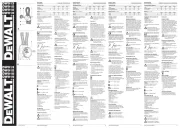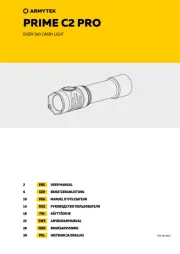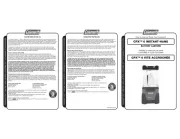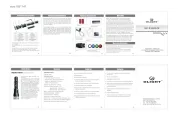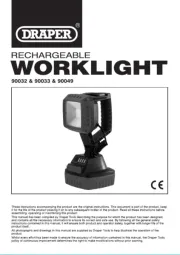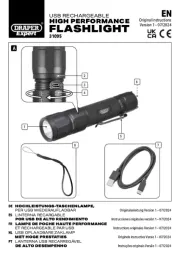DEWALT Industrial Tool Co., 701 East Joppa Road, Baltimore, MD 21286
(JAN07) Form No. 648203-00 DC509, DC519 Copyright © 2006, 2007 DEWALT
The following are trademarks for one or more DEWALT power tools: the yellow and black color scheme; the “D” shaped
air intake grill; the array of pyramids on the handgrip; the kit box configuration; and the array of lozenge-shaped humps
on the surface of the tool.
IF YOU HAVE ANY QUESTIONS OR COMMENTS ABOUT THIS OR ANY DEWALT TOOL, CALL US
TOLL FREE AT: 1-800-4-DEWALT (1-800-433-9258)
General Safety Rules
WARNING! Read all instructions. Failure to
follow all instructions listed below may result in
electric shock, fire and/or serious injury. The term “power
tool” in all of the warnings listed below refers to your
mains-operated (corded) power tool or battery-operated
(cordless) power tool.
SAVE THESE INSTRUCTIONS
1) WORK AREA SAFETY
a) Keep work area clean and well lit. Cluttered or dark areas invite accidents.
b) Do not operate power tools in explosive atmospheres, such as in the presence of flammable
liquids, gases or dust. Power tools create sparks which may ignite the dust or fumes.
c) Keep children and bystanders away while operating a power tool. Distractions can cause you to
lose control
2) ELECTRICAL SAFETY
a) Power tool plugs must match the outlet. Never modify the plug in any way. Do not use any
adapter plugs with earthed (grounded) power tools. Unmodified plugs and matching outlets will
reduce risk of electric shock.
b) Avoid body contact with earthed or grounded surfaces such as pipes, radiators, ranges and
refrigerators. There is an increased risk of electric shock if your body is earthed or grounded.
c) Do not expose power tools to rain or wet conditions. Water entering a power tool will increase
the risk of electric shock
d) Do not abuse the cord. Never use the cord for carrying, pulling or unplugging the power tool.
Keep cord away from heat, oil, sharp edges or moving parts. Damaged or entangled cords
increase the risk of electric shock. Replace or repair damaged cords. Make sure your extension cord
is in good condition. Use only 3-wire extension cords that have 3-prong grounding-type plugs and
3-pole receptacles that accept the tool’s plug.
e) Do not use outdoors.
3) PERSONAL SAFETY
a) Stay alert, watch what you are doing and use common sense when operating a power tool. Do
not use a power tool while you are tired or under the influence of drugs, alcohol or medica-
tion. A moment of inattention while operating power tools may result in serious personal injury.
b) Use safety equipment. Always wear eye protection. Safety equipment such as dust mask,
non-skid safety shoes, hard hat, or hearing protection used for appropriate conditions will reduce
personal injuries.
c) Avoid accidental starting. Ensure the switch is in the off-position before plugging in. Carrying
power tools with your finger on the switch or plugging in power tools that have the switch on invites
accidents.
d) Remove any adjusting key or wrench before turning the power tool on. A wrench or a key left
attached to a rotating part of the power tool may result in personal injury.
e) Do not overreach. Keep proper footing and balance at all times. This enables better control of
the power tool in unexpected situations.
f) Dress properly. Do not wear loose clothing or jewellery. Keep your hair, clothing and gloves
away from moving parts. Loose clothes, jewellery or long hair can be caught in moving parts. Air
vents often cover moving parts and should also be avoided.
g) If devices are provided for the connection of dust extraction and collection facilities, ensure
these are connected and properly used. Use of these devices can reduce dust-related hazards.
4) POWER TOOL USE AND CARE
a) Do not force the power tool. Use the correct power tool for your application. The correct power
tool will do the job better and safer at the rate for which it was designed.
b) Do not use the power tool if the switch does not turn it on and off. Any power tool that cannot
be controlled with the switch is dangerous and must be repaired.
c) Disconnect the plug from the power source and/or the battery pack from the power tool
before making any adjustments, changing accessories, or storing power tools. Such preventive
safety measures reduce the risk of starting the power tool accidentally.
d) Store idle power tools out of the reach of children and do not allow persons unfamiliar with
the power tool or these instructions to operate the power tool. Power tools are dangerous in
the hands of untrained users.
e) Maintain power tools. Check for misalignment or binding of moving parts, breakage of parts
and any other condition that may affect the power tools operation. If damaged, have the
power tool repaired before use. Many accidents are caused by poorly maintained power tools.
f) Keep cutting tools sharp and clean. Properly maintained cutting tools with sharp cutting edges are
less likely to bind and are easier to control.
g) Use the power tool, accessories and tool bits etc., in accordance with these instructions and
in the manner intended for the particular type of power tool, taking into account the working
conditions and the work to be performed. Use of the power tool for operations different from those
intended could result in a hazardous situation.
5) BATTERY TOOL USE AND CARE
a) Ensure the switch is in the off position before inserting battery pack. Inserting the battery pack
into power tools that have the switch on invites accidents.
b) Recharge only with the charger specified by the manufacturer. A charger that is suitable for one
type of battery pack may create a risk of fire when used with another battery pack.
c) Use power tools only with specifically designated battery packs. Use of any other battery packs
may create a risk of injury and fire.
d) When battery pack is not in use, keep it away from other metal objects like paper clips, coins,
keys, nails, screws, or other small metal objects that can make a connection from one termi-
nal to another. Shorting the battery terminals together may cause burns or a fire.
e) Under abusive conditions, liquid may be ejected from the battery, avoid contact. If contact
accidentally occurs, flush with water. If liquid contacts eyes, additionally seek medical help.
Liquid ejected from the battery may cause irritation or burns.
6) SERVICE
a) Have your power tool serviced by a qualified repair person using only identical replacement
parts. This will ensure that the safety of the power tool is maintained.
Safety Rules for Flexible Floodlights
WARNING: Burn hazard. Do not operate flashlight or
charger near flammable liquids or in gaseous or explosive
atmospheres. Internal sparks may ignite fumes causing
personal injury.
WARNING: Lens and bulb become hot during use.
• During or immediately after use, don’t lay flexible floodlight flat on lens surface.
• Don’t touch lens surface when bulb is lit or immediately after use.
• Handle flexible floodlight with care around any flammable surface.
• If bulb has been lit, let flexible floodlight cool for several minutes before changing bulb.
• Do not expose light or charger to wet or damp areas. Do not expose light or charger to rain or snow.
• Do not wash light or charger with water or allow water to get inside light or charger. Do not submerge
light in water at any time.
• While light is in use, do not cover with cloth or other flammable materials due to increased risk of fire.
• Before using battery and charger, read instructions and cautionary markings on charger, battery ALL
pack, and product using battery pack. The DC509 is designed only for use with the DEWALT DC9360
36 Volt lithium ion battery. The DC519 is designed only for use with the D WALT DC9280 28 Volt E
lithium ion battery only. The DC9360 and DC9280 lithium battery can only be charged with the DC9000
charger. Lithium battery and charger safety information and instructions may also be found in other
lithium ion tool instruction manuals. Please refer to the chart on the last page of the manual.
CAUTION: Burn hazard. To reduce the risk of injury,
charge only DEWALT lithium ion batteries. Other types
of batteries may burst causing personal injury and
damage.
CAUTION: When not in use, place tool on its side
on a stable surface where it will not cause a tripping
or falling hazard. Some tools with large battery packs
will stand upright on the battery pack but may be easily
knocked over.
• The label on your tool may include the following symbols.
V ...................volts A................... amperes
Hz .................hertz W ................. watts
min ................ minutes ................ alternating current
..............direct current no ................. no load speed
.................Class II Construction …/min .......... revolutions or reciprocation
.................earthing terminal ..................... per minute
.................safety alert symbol
Installing and Removing the Battery Pack (Fig. 1, 2)
NOTE: Make sure your battery pack is fully charged.
CAUTION: Make certain the switch is in the OFF
position before removing or installing battery.
To install the battery pack into the tool handle, align the base of the tool with the rails inside the tool’s
handle and slide the battery pack firmly into the handle until you hear the lock snap into place (Fig. 1).
To remove the battery pack from the tool, press the release button and firmly pull the battery pack out of
the tool handle. Insert it into the charger (Fig. 2) as described in the charger section of this manual.
Switch (Fig. 3)
To turn the light on, slide the switch to the side. To turn it off, slide the switch back.
Replacing the Light Bulb (Fig. 4, 5)
Floodlight Cat. No Replacement Bulb Cat. No.
DC509, DC519 DW9083
WARNING: Burn Hazard. Lens and bulb become hot
during use. Do not touch lens surface when bulb is lit or
immediately after use.
INSTRUCTION MANUAL
GUIDE D'UTILISATION
MANUAL DE INSTRUCCIONES
DC509 36V Cordless Flexible Floodlight
DC519 28V Cordless Flexible Floodlight
Projecteur flexible sans fil de 36 V DC509
Projecteur flexible sans fil de 28 V DC519
Linterna flexible inalámbrica DC509 de 36 V
Linterna flexible inalámbrica DC519 de 28 V
INSTRUCTIVO DE OPERACIÓN, CENTROS DE SERVICIO
Y PÓLIZA DE GARANTÍA. ADVERTENCIA: LÉASE ESTE
INSTRUCTIVO ANTES DE USAR EL PRODUCTO.
POWER PACK (NOT INCLUDED) • BLOC-PILES (NON
FOURNI) • PAQUETE DE ENERGÍA (NO INCLUIDO)
SWITCH
INTERRUPTEUR
INTERRUPTOR
FIG. 4
LENS HOLDER
PORTE-LENTILLE
SOPORTE DE
LA LENTE
BULB
AMPOULE
BOMBILLA
FIG. 2
FIG. 3 FIG. 5
FIG. 1
BATTERY RELEASE BUTTON
BOUTON DE DÉGAGEMENT
DU BLOC-PILES
BOTÓN DE LIBERACIÓN
DE LA BATERÍA
If you have questions or comments, contact us.
Pour toute question ou tout commentaire, nous contacter.
Si tiene dudas o comentarios, contáctenos.
1-800-4-D WALT • www.dewalt.comE

